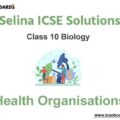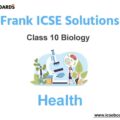Q) Multiple Choice Questions:-
1) Penicillin is an ______.
a) antibiotic
b) antianalgeric
c) antipyretic
Solution: (c) An antibiotic
2) ‘T’ in DTP vaccination stands for
a) Tuberculosis
b) Typhoid
c) Tetanus
d) Tonsillitis
Solution: (c) Tetanus
3) DPT stands for
a) Diphtheria, Polio and Tetanus
b) Diphtheria, Pertussis and Tetanus
c) Dysentery, Polio and Typhoid
d) Diphtheria, Polio and Typhoid
Solution: (b) Diphtheria, Pertussis and Tetanus
4) Vaccines are
a) An extract of toxins secreted by bacteria
b) An extract of dead and weakened microbes
c) Strong chemicals obtained from fungi
d) Chemicals that are applied on the skin to kill bacteria
Solution: (b) An extract of dead and weakened microbes
Q) Name the following:
1) The drug based on arsenic compound, produced in 1910, which killed germs of syphilis
2) The antibiotic that was discovered first.
3) The category of immunity required in the treatment of snake-bite.
4) Any four antiseptics, any two disinfectants and any two antibiotics.
5) The vaccine that helps to produce immunity against polio.
Solution:
1) Arsphenamine or Salvarsan.
2) Penicillin
3) Passive acquired immunity
4) Antiseptics – Lysol, iodine, boric acid and carbolic acid Disinfectants – Cresol and phenol
5) Oral polio vaccine (OPV)
Q) Very Short Answer Type:-
1) Write the full forms of:
i) AIDS
ii) BCG
iii) DPT vaccine
iv) WTO
v) HIV
vi) STD
Solution:
(i) Acquired Immuno Deficiency Syndrome
(ii) Bacillus Calmette Guerin
(iii) Diphtheria, Pertussis and Tetanus vaccine
(iv) World Health Organization
(v) Human Immunodeficiency Virus
(vi) Sexually Transmitted Disease
Q) Give the technical term for the kind of proteins produced in the blood to fight and destroy harmful microbes.
Solution:
Antibodies are immunoglobulins which are produced in the blood to fight and destroy harmful microbes.
Q) Mention if the following statement is true (T) or false (F).
1) Lysol is an antibiotic.
a) True
b) False
Solution: False. Lysol is an antiseptic.
2) Sweat and tears contain germs-killing substances.
a) True
b) False
Solution: True
3) Our body can make only a limited variety of different antibodies.
a) True
b) False
Solution: False. Our body can make an unlimited variety of different antibodies.
4) Salk vaccine is used against tuberculosis.
a) True
b) False
Solution: False. Treatment by the use of chemicals is known as chemotherapy.
5) Treatment by the use of chemicals is known as allopathy.
a) True
b) False
Solution: False. Treatment by the use of chemicals is known as chemotherapy.
6) Alexander Fleming coined the term ‘antibiotic’ for substances like penicillin.
a) True
b) False
Solution: False. Selman Waksman coined the term ‘antibiotic’ for substances like penicillin.
7) DDT is a disinfectant.
a) True
b) False
Solution: True
8) Vaccine provides the body with active immunity.
a) True
b) False
Solution: False. Vaccine provides the body with passive immunity.
9) Penicillin was discovered by Alexander Fleming.
a) True
b) False
Solution: True.
10) BCG is the vaccine given to babies to help build immunity against three common diseases.
a) True
b) False
Solution: False. BCG is the vaccine given to babies to help build immunity against tuberculosis.
Question 1) Differentiate between the following:
(a) Antiseptic and Antibiotics
(b) Disinfectant and Antiseptic
(c) Vaccination and sterilisation
(d) Active immunity and passive immunity
(e) Innate immunity and acquired immunity
Solution:
(a) An antibiotic is a chemical substance generated by a microbe that can kill or prevent the growth of some other disease-producing bacteria. An antiseptic is a mild chemical agent that is given to the body to kill germs.
(b) In contrast to deodorants, which are neither antiseptics nor disinfectants but rather aerosols used to cover up an unpleasant odor, disinfectants are potent chemicals administered to areas or sites on the body where germs live and reproduce.
(c) Sterilization is the process of eliminating or killing all the microbes present on a surface, contained in a fluid, in medication, or in a compound such as biological culture media, whereas vaccination is the introduction of any kind of dead or weakened germs into the body of a living being to develop immunity (resistance) against a disease.
(d) Passive immunity is the defense offered to a person by an outside source in the form of “readymade” antibodies. Active immunity is the defense created by a person as a result of a prior illness or antigen that enters the body naturally.
(e) Innate immunity, which is inherited from parents, is immunity that exists as a result of a person’s genetic composition. Unlike acquired immunity, which is a disease resistance that a person develops over the course of a lifetime, natural immunity is present in the body without any external stimulus or prior illness. Either a prior infection or externally given ready-made antibodies might have caused it.
Q) Short Answer Type:-
Question 1) Name any three vaccines and the diseases for which they provide immunity.
Solution:
Below are the vaccines and the diseases:-
(i) TAB vaccine for typhoid
(ii) BCG vaccine for measles
(iii) DTP vaccine for diphtheria, tetanus and whooping cough
Question 2) Given below is a table of certain vaccines, the diseases against which they are used and the nature of vaccine. Fill up the gaps 1-10.

Solution:

Q) Given below are the groups of certain substances of particular categories. Mention the category of group and identify the wrong example giving reason.
Question 1) Lysol, benzoic acid, DDT, mercurochrome.
Solution:
Antiseptics:- Lysol, benzoic acid, mercurochrome
As a disinfectant that is bad for human skin, DDT is a poor example for this group.
Question 2) Formalin, iodine, lysol, phenol
Solution:
Disinfectants:- Formalin, lysol, phenol
Because it is an antiseptic, iodine is a poor example.
Question 3) BCG, DTP, ATP
Solution:
Vaccines:- BCG, DTP
Because it is an energy carrier in the cells of every known organism, ATP is a poor example.
Question 4) Tears, skin, nasal secretion, HCl (in stomach)
Solution:
Germ-killing secretions:- Tears, nasal secretion, HCl (in stomach) Skin is a poor example since it serves as a mechanical barrier that keeps pathogens from entering our bodies.
Q) Short Answer Type:-
Question 1) Given below is a scheme of classifying immunity against human diseases. Fill up the types of immunity in the blanks 1-9.

Solution:
Below are the human diseases:-
(1) Innate immunity
(2) Acquired immunity
(3) Specific immunity
(4) Active acquired immunity
(5) Passive acquired immunity
(6) Natural acquired active immunity
(7) Artificial acquired active immunity
(8) Natural acquired passive immunity
(9) Artificial acquired passive immunity
Question 2) List any four ways in which the antibiotics are being used.
Solution:
1. The use of antibiotics in treating illnesses is widespread.
2. Particularly for fresh meat and fish, certain antibiotics are utilized as food preservatives.
3. To treat animal feed and prevent internal infection, several antibiotics are utilized.
4. Some antibiotics are employed in the management of plant infections.
Question 3) List the merits of local defense systems.
Solution:
Benefits of local defense systems include:
1. Local defense systems immediately begin to function.
2. These systems are independent of prior infection exposure.
3. They work well against a variety of potentially contagious agents.
Question 4) Suppose a person develops the disease diphtheria. Comment upon the principle of the treatment he should receive.
Solution:
A dangerous bacterial infectious illness, diphtheria. If left untreated, it can cause heart failure or paralysis in extreme cases. It also causes colds, coughs, and sneezes. Medication and supportive care are both used throughout the course of treatment. The most crucial procedure is the quick intravenous delivery of the safe diphtheria toxoid. Once delivered, the safe toxoid causes the body of the patient to produce antibodies against the bacteria that cause diphtheria.
Q) Long Answer Type:-
Question 1) The principle of vaccination is to produce immunity against a disease. Explain.
Solution:
1.) The method of purposely injecting germs or germ substances into the body in order to build resistance to specific illnesses is known as vaccination.
2. This procedure is known scientifically as prophylaxis, and the substance that is injected into the body is known as the vaccination.
3.) The vaccination or germ material is ingested occasionally orally as well as through injection (e.g. polio drops).
4.) The vaccination encourages lymphocytes to create antibodies against the specific disease’s germs within the body.
5.) Antibodies are essential to our immune system. They have the duty of destroying foreign substances that enter the body.
6.) Immune systems are signaled by vaccines to manufacture certain antibodies. Therefore, the goal of vaccination is to build immunity to a disease.
Question 2) ”Abnormally, large numbers of WBCs in the blood are usually an indication of some infection in our body”. Comment on the statement.
Solution:
An alert is given to the immune system to manufacture certain antibodies whenever a pathogen or illness enters the body. White blood cells begin to expand quickly to keep up with the amount of pathogens growing within the body. They are able to manufacture more antibodies as a result, which helps them to quickly stop the illness. Therefore, excessively high WBC counts in the blood are often a sign that our body is infected.
Question 3) Explain briefly, the role of the following health aids:
a) Antiseptics
b) Define the following: Disinfectants
c) Define the following: Vaccine
Solution:
(a) Antiseptics are gentle chemicals that are administered to the body that stop some germs from growing while destroying others. Iodine and Lysol, for instance.
(b) Disinfectants are substances that destroy germs when they come into touch with them. Typically, disinfectants are too potent to be applied to the body. Cresol and phenol, for instance.
(c) Vaccines are substances that are given into the body to give passive immunity. Typically, the materials are bacteria or something that microorganisms release. OPV (oral polio vaccination) and DTP are two examples (diphtheria, tetanus and pertussis).




